Hall of Fame lead guitarist Mike McCready holds an odd place in the realm of rock and roll. Joined by his ever enigmatic band, Pearl Jam, McCready has been consistently productive, inventive, and admired for over 30 years. Yet too many people who are not guitarists nor passionate Pearl Jam fans barely hold the faintest idea of who he is.
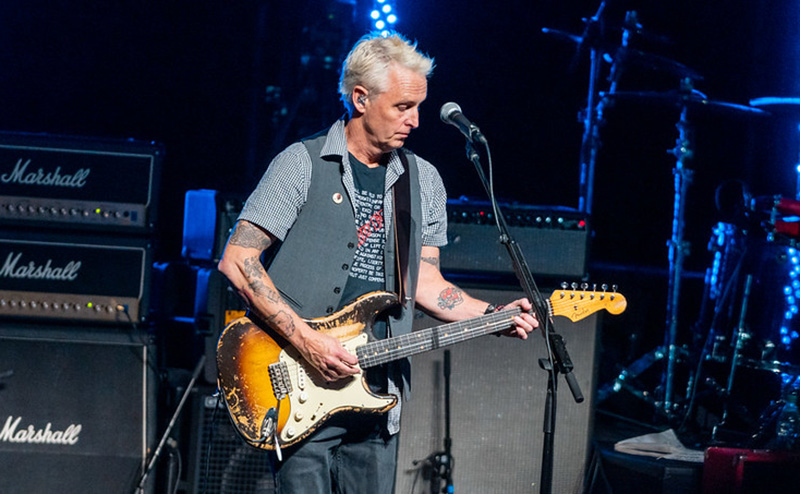
Mike is one of the laid back key pieces that led to the distinguished sound that defined the Seattle Grunge scene that swept the 90s. Embodying an innovative yet unrefined sound to an extent, McCready is the axis that delivers beautiful melodies and punch packed chord structures that make for Pearl Jam’s characteristically aggressive sound.
What Guitars Does Mike McCready Play?
Mike McCready primarily plays Gibson Les Paul and Fender Stratocaster guitars. Over the years he’s played many different guitars live and in the studio, but the most notorious surely being his 1959/1960 Fender Stratocaster and his Honeyburst 1959 Gibson Les Paul Standard.
See the full list of Mike McCready guitars and gear below.
1959 Gibson Les Paul Standard

| Finish | Honeyburst |
| Years Used | 1998 to Present |
Video: See Mike McCready using his 1959 Gibson Les Paul at Fenway Park here.
The first true member of McCready’s 1959 family, and probably the only other guitar he favors as much as his ’60 Strat, his particular ’59 Honeyburst Les Paul Standard is infused with rock history. McCready has regaled the guitar’s illustrious background often. As he tells it, Jim Armstrong, the Irish guitarist from Them, purchased the ’59 around 1967. Nearly 30 years later, Armstrong’s daughter helps him sell the guitar through Danny Mangold (Danny’s Music”).
Mangold eventually contacted McCready to see if he was interested. The $25,000 price tag was a speed bump for McCready, despite his band’s consistent, early success. Mike gave in to the pull, traded in a few guitars along with some cash, and took home what would become his “king of kings.”
McCready relies on his ’59 Les Paul for nearly every performance of “Alive.” The two-piece maple/mahogany body and dual Custom-buckers drive the seemingly infinite sustain that McCready’s covets. A maple neck and Indian Rosewood fingerboard, staples of the L.P.’s, include tortoiseshell dots and cellulose inlays.
In 2016, Gibson Custom announced a 50-piece replica run of the Mike McCready 1959 Les Paul Standard, priced at a mere $11,449.
Fender 1959/60 Stratocaster

| Finish | Three-Colour Sunburst |
| Years Used | 1991 to Present |
Video: See Mike McCready using his 1959/60 Stratocaster in The Fixer music video here.
Right after Ten boosted the income of the band members, McCready sought out a guitar that would further connect him to one of his childhood heroes, Stevie Ray Vaughan – thus leading him to a ’59 Stratocaster. He found his already well-worn talisman in at Danny’s Music shop, north of Seattle. Recently, he told Guitar World that he bought what would be correctly identified as a 1960 Strat just before Pearl Jam opened for the Rolling Stones for roughly $7,000.
While this guitar might not have made its appearance in Ten during the studio sessions, it certainly became the most battled guitar of the golden year of Grunge. It would eventually become McCready’s trademarked piece, sported in essentially every live show ever since he first got it, only to inspire his very own signature line years later.
In April 2021, the Fender Custom Shop announced it was releasing a limited edition of McCready’s prized Strat. As Fender’s Vincent Van Trigt was dissecting McCready’s guitar in 2020, he discovered that it was actually 1960 rather than a ’59, as Mike had believed all along. Being the first of McCready’s obsession with ’59 guitars, he had even had the number tattooed on the inside of this left wrist. Now his first vintage guitar had a new identity.
McCready’s ’60 features a classic, two-piece alder body, a flat-sawn flame maple neck with a 1960 ‘oval C’ profile, and a 21-fret rosewood fingerboard. Three south-wound pick-ups and a tremolo bridge provided the signature tone. He continues to feature the ’60 live on “Even Flow,” “Yellow Ledbetter,” the “Star-Spangled Banner,” and Gigaton’s “Dance of the Clairvoyants.”. Fittingly, he rotates this and the King of Kings Les Paul for these iconic tunes, and hard evidence would be Pearl Jam’s live performance at the Madison Square Garden back in 2003.
One of the sixty Fender Limited Edition Mike McCready 1960 Stratocasters could have been yours for $15,000. Unfortunately, though, they’re gone!
1972 Gibson “Black Beauty” Les Paul
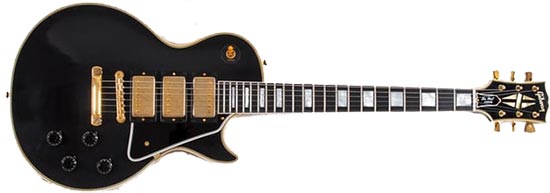
| Finish | Black |
| Years Used | 1992 to 2000 |
In mid-1992, Pearl Jam and Neil Young joined forces to play Young’s 1989 hit, “Rockin’ in the Free World.” during MTV’s golden era. Pearl Jam along with Neil decided to use some top-of-the-shelf gear to completely thrash the stage as the performance came to an end. When the camera lands on McCready, you can see him sledgehammering his Black Beauty into a smoking a Marshall in the waning feedback. On the other hand, it turns out that this Les Paul could in fact take so much punishment, given that this wouldn’t be the first time Mike would do this.
McCready’s ’72 Black Beauty reissue, had three gold humbuckers, a solid mahogany body, a chunky C-shape mahogany neck, ebony fretboard, and gold hardware. Mike played the Black Beauty during mid to late 90s P.J. tours and with Mad Season in 1995.
One of his techs talked of picking the Les Paul off the floor on many occasions, as this was a common show antic during the post “Ten” era into “VS “and “Vitalogy”. As for the Black Beauty Custom Les Paul, it became a stunt double to its Standard yellow burst twin, it took only so many blows to make this Gibson staple go out of rotation when it became unfixable sometime during the new millennium.
1962 Fender Stratocaster Reissue

| Finish | Black |
| Years Used | 1989 to 1992 |
When McCready reentered the Seattle music scene after Shadow had disbanded, he famously reconnected with Stone Gossard, whom he’d met from his early years in high school, with Jeff Ament. This pair gave Mike the black ’62 Strat reissue that he would play with Temple of the Dog and during very early Pearl Jam gigs. This precursor to his beloved ’60 Strat cemented his obsession with Fender.
This alder-body reissue came with a trio of vintage single-coil pick-ups, a maple neck, 21-fret rosewood fingerboard, a white pickguard, and vintage-style vibrato/bridge. You can catch a glimpse of McCready playing on “Hunger Strike” with Temple of the Dog wielding this Stratocaster. Furthermore, this Stratocaster became one of McCready’s most highlighted pieces of the 90s up until the introduction of a similar white one, and eventually, it was retired when Mike met his match on his iconic 60s Strat. McCready spoke about his early guitars in a recent Guitar World article with this one as a key piece during his early years.
1962 Fender Telecaster
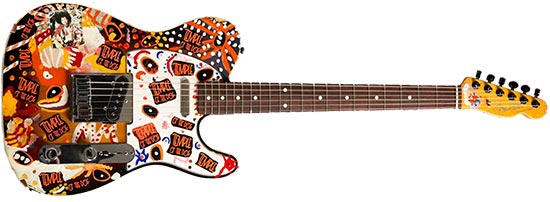
| Finish | Multi-Colored Stickers |
| Years Used | 1990 to 2016 |
McCready’s first band, Shadow, relocated to L.A. in hopes of a record deal but didn’t garner enough interest. They moved back to Seattle in 1988 and broke up. McCready hung up his guitar for a while until he discovered one of his future idols, Stevie Ray Vaughan, during a show at The Gorge. Within a few months, McCready, Gossard, and Ament were invited to join Temple of the Dog, McCready’s career resumed. Although this guitar may be iconic in its own way, it was rarely employed at Pearl Jam’s concerts, and instead, it remained as the original Temple of the Dog iconic six-string.
When Mike got his ’62 Strat, so he decided to acquire a ’62 Telecaster a few days apart, as he recently became rather enthusiastic over the Fender sound. He pained the body and covered it with TOTD stickers, random quotes, and a Jimi Hendrix decal. McCready also played this one during the 1992 PINKPOP festival. Other footage of Mike with this Tele is scarce, but he was briefly reunited with it prior to the 2016 TOTD reunion tour. Collector Ian Linde had purchased the ’62 from someone close to Pearl Jam and contacted McCready to see if he’d be interested in taking the guitar on tour.
After a few years well into the 90s, McCready would retire and re-introduce this guitar into his rig line-up, but only for his tenure fronted by Chris Cornell. Regardless of this, he continued to use this Tele up until 2016 when it was last seen prior to Cornell’s passing. With Temple of the Dog’s disbandment out of respect to his friend, so it seems that it will take some time for anyone to see this 62 Telecaster again. This is easily one of the most iconic Mike McCready guitars of all time.
1959 Gibson Les Paul Jr.
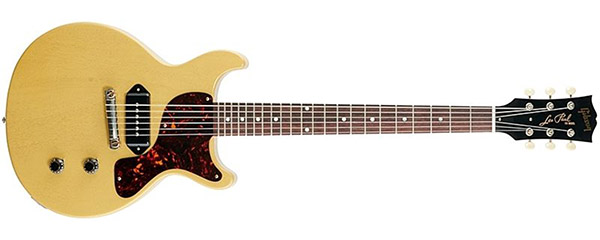
| Finish | TV Yellow |
| Years Used | 2006 to Present |
This entry is the cool little brother of the McCready ’59 family. His T.V. Yellow (a color some say was suggested by Les Paul so that it wouldn’t distort early T.V. signals) was a 40th birthday present from his wife, Ashley. The funky, lightweight double-cutaway body was made from mahogany and, despite being labeled a “Junior,” had been full size since 1955.
Maintaining a clean, straightforward design, with one hearty P-90 pick-up just above the bridge, the ’59 LP Jr. has taken on a prominent role in recent years. McCready thrashes it during the “Mind Your Manners” video from 2013 and has consistently played it live. Two great examples are on “Down,” a Lost Dogs track recorded in Amsterdam in 2018, and on several songs during the 2018 Brazil Lollapalooza show.
Matao Custom Les Paul
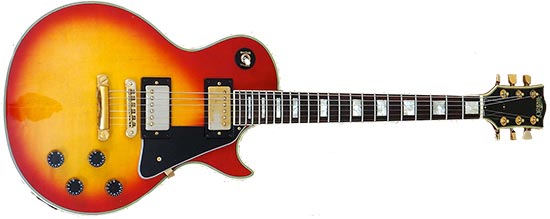
| Finish | Cherry Sunburst |
| Years Used | 1977 to Present |
To this day, Mike still owns his first guitar, a Japanese-made Matao Les Paul replica he bought at age 11. This one would take him into his first band, Shadow, a couple of years later. Matao instruments often lumped into a group of “lawsuit guitars”, which became infamous for their recurring legal issues.
Matao, a line produced by Hoshino, also known as the group that made Ibanez, fabricated guitars that blatantly copied the designs from Gibson, Fender, and others. Despite the controversy surrounding these guitars, they are regarded as well-crafted instruments and became a very regular find as well as a popular go-to budget brand during the late 80s into the 90s.
Fender Stratocaster

| Finish | Yellow |
| Years Used | 1991 to Unspecified |
This Strat shows up in Pearl Jam’s 1992 set at the Dutch PINKPOP festival. Not much has been disclosed about this guitar. It was mainly used as a backup touring guitar during 1991-1993 tours, standing in for his recently purchased 59/60 Stratocaster. He also plays a deep red S.G. on “Rockin’ in the Free World” to close out their set.
This standard Strat made quite a few appearances, but mainly on live performances until it was eventually retired, there’s not much information about it.
Takamine Fp 340SC
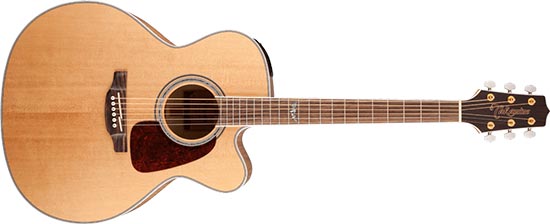
| Finish | Natural |
| Years Used | 1992 |
The majority of rock’s lead guitarists aren’t known for their choice of acoustic guitars. While McCready pulls one out for acoustic sets and a few recordings, he tends to follow that trend, but this Takamine six-string at some point was one of the most highlighted pieces on his catalog thanks to Mike and his bandmates. In 1992, Pearl Jam recorded their Unplugged session, and at the time MTV could launch any artist into international stardom and recognition with this short-lived golden age of music television.
As was the case for Nirvana and Pearl Jam, many of their contemporaries became subject to massive mimicking after their performances in this particular show, it is reported that Takamine went up a tier as manufacturers following the album “Ten” being performed stripped back.
He told one interviewer while describing “Sirens” from 2013’s Lightning Bolt that he has several acoustic guitars and tends to write on a Taylor.
Rickenbacker 660-12TP Tom Petty Signature
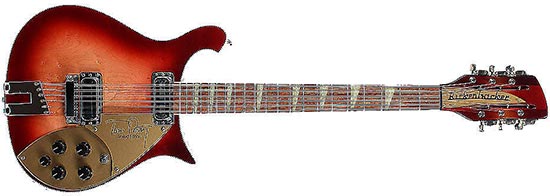
| Finish | Fireglo |
| Years Used | 1993 to Present |
Tom Petty was always known as a generous man, but how many guitarists, two albums into their career, can say that Tom gave them a guitar? McCready for one can say such a thing. Petty gave Mike one of his signature Rickenbackers, a 660 twelve-string, as the band recorded Vitalogy. McCready promptly used it to record “Not for You” and “Corduroy.”
As for this particular model, the 660-12TP has a limited run of 1000. It was produced with a solid birds-eye maple body, rosewood fretboard, and a pair of vintage Rickenbacker Toaster Top pick-ups and the traditional Rickenbacker fireglo finish this time made into a matte paint job.
McCready played this guitar live during several shows in the 90s, but it’s disappeared in recent years, likely stored safely at home as Mike has referred to some of his most precious gear and items.
1953 Fender Telecaster Reissue

| Finish | Blonde |
| Years Used | 2000 to Present |
You can find many confusing and conflicting reports of McCready’s early 50’s Telecasters. A few articles and rig rundowns list a ’52 and ’53, assumed to be reissued. The ’52 was technically a Broadcaster, but future reissues renamed it, Telecaster, mostly because Gretsch sued Fender for trademark infringement. For McCready and Pearl Jam, the year 2000 was one for reinvention and departure of their glory days during the early 90s, so he decided to get himself a piece of history and try new sounds.
During the 00s, this became Mike’s main go-to along with his beloved 60s Stratocaster, you can see it in almost every Pearl Jam live performance and in the video for “Love Boat Captain” from 2009.
The ’53 reissue boasts a one-piece, bolt-on maple neck, an ash body with a translucent butterscotch finish, and a black Bakelite pickguard. It can be identified by its burn mark on its headstock, just above the high E string. The original ’53s were sold for $189.50. The current value for one in the excellent, all-original condition is $25,000.
Gibson 1997 EDS 1275 double-neck guitar
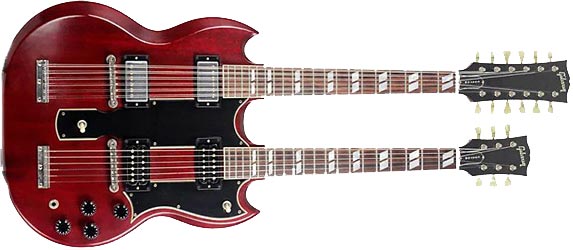
| Finish | Cherry Red |
| Years Used | 1994 |
When McCready co-founded grunge supergroup Mad Season in 1994, the short-lived magic produced a single album, Above. Mike bought the double neck (6-string/12-string) specifically for the Mad Season recording sessions. He joked that he “looked like an idiot” play the beast but that it sounded amazing.
The specs for the EDS 1275 are consistent with Gibson’s S.G. and Les Paul models. A solid mahogany body and neck, topped with an Indian Rosewood fretboard, two Custombucker pick-ups, and a black 5-ply pickguard dress out this 13-pound 2-headed behemoth.
1991 Gretsch Silver Jet Reissue
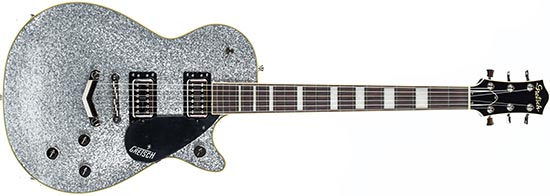
| Finish | Silver Sparkle |
| Years Used | 1996 to Present |
Brooklyn-born Gretsch guitars place a distant third in McCready’s impressive inventory. Billy Zoom, punk legend of the L.A. band X, began playing a ’55 Silver Jet in the ’70s, eventually working with the manufacturer to produce a tribute model in 2007. McCready’s reissue, which he began playing around 1996, predated the “Billy Zoom” model, but this stunning solid body has been synonymous with Zoom for decades.
Like many of McCready’s guitars, the Silver Jet emerges from time to time. You can catch of glimpse of it in the 1996 live version of “Present Tense” recorded in Budapest. The Silver Jet features a solid mahogany body, maple neck, and rosewood fretboard. A pair of TV Jones Classic Humbuckers sit atop the silver sparkle finish. The Adjusto-Matic bridge is crowned with a Bigsby B3C Vibrato and perfectly matched nickel tuners top off the headpiece.
1970’s Gibson/Ibanez Flying V
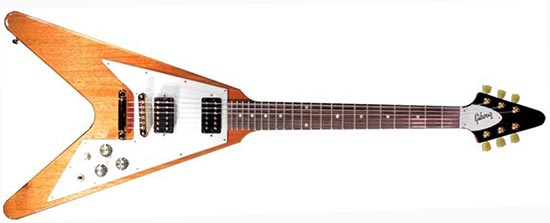
| Finish | Natural |
| Years Used | 1998 to Present |
While McCready owns and occasionally plays a black Gibson Flying V, he rotates between it and an almost identical Ibanez natural V model. He’s blanketed the body with dozens of tiny stickers. This guitar shows up as early as 2000 on “Rearviewmirror” from the Touring Band DVD and later in 2006 on Late Night with David Letterman. These guitars, dubbed Rocket Roll’s, featured a lightweight swamp ash body, maple neck, rosewood fingerboard, and twin Ibanez humbuckers.
Gretsch 1958 6119 Chet Atkins Tennessean
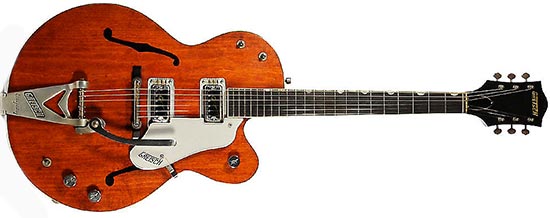
| Finish | Orange |
| Years Used | 2002 to Present |
The second significant Gretsch in this list is a killer. A bright orange ’58 Chet Atkins Tennessean, favored by legends such as George Harrison, Duane Eddy, and Brian Setzer. McCready played this guitar during “Thumbing My Way” in an intimate set from Seattle’s Chop Suey in 2002.
The standard build for the Tennessean included a mahogany archtop hollow body with a maple veneer, an ebony fretboard, and a single Filter ‘Tron pick-up. Two massive f-holes and a Bigsby tremolo rounded out the design. Another Gretsch appears during “Hold On” from the 2018 Brazil Lollapalooza set, but the subtle lighting makes it difficult to identify. Could be the Orange ’58 or the White Falcon or a new one!
1970 Fender “David Gilmour” Signature Series Stratocaster

| Finish | Black |
| Years Used | 2013 to Present |
Several rig rundowns list this beautiful 2012 reissue in Mike’s portfolio, and it’s obviously a model that any self-respecting Strat-lover would want to own. There’s an entire book dedicated to this one guitar! Based on David Gilmour’s original 1970 “Black Strat,” Fender’s reissue sports an alder body, a black pickguard, a solid maple neck, three custom pick-ups (a ‘50s single-coil, ’69 single-coil, and a Seymour Duncan SSL-5), and Gilmour’s modified electronics and vintage tremolo.
Table Showing Each Guitar Mike McCready Has Played at Each Point of His Career
| Make | Model | Color/Finish | Years |
|---|---|---|---|
| Matao | Custom Les Paul | Cherry Sunburst | 1977 to Unspecified |
| Fender | 1962 Stratocaster Reissue | Black | 1989 to 1992 |
| Fender | 1962 Telecaster | Multi-Colored Stickers | 1990 to 2016 |
| Fender | Stratocaster | Yellow | 1991 to Unspecified |
| Fender | 1959/60 Stratocaster | Three-Colour Sunburst | 1991 to Present |
| Takamine | FP 340SC | Natural | 1992 |
| Gibson | 1972 “Black Beauty” Les Paul | Black | 1992 to 2000 |
| Rickenbacker | 660-12TP Tom Petty Signature | Fireglo | 1993 to Present |
| Gibson | 1997 EDS 1275 double-neck guitar | Cherry Red | 1994 |
| Gretsch | 1991 Silver Jet Reissue | Silver Sparkle | 1996 to Present |
| Gibson | 1959 Les Paul Standard | Honeyburst | 1998 to Present |
| Gibson/Ibanez | 1970s Flying V | Natural | 1998 to Present |
| Fender | 1953 Telecaster Reissue | Blonde | 2000 to Present |
| Gretsch | 1958 6119 Chet Atkins Tennessean | Orange | 2002 to Present |
| Gibson | 1959 Les Paul Jr. | T.V Yellow | 2006 to Present |
| Fender | 1970 “David Gilmour” Signature Stratocaster | Black | 2013 to Present |
Mike McCready Amplifier Overview
McCready has continually chased his dream tone over his thirty-plus-year career. Unmistakably so, McCready has repeatedly tweaked his rig from humble Fender Champ beginnings to his apparent obsession with vintage tube heads. Here are a few of the critical elements of his elusive tone.
Fender Vibro Champ
Years Used: 1977 to Unspecified
McCready powered up his Mateo Les Paul with this classic low-wattage Fender mainstay. It didn’t take him long to swap out this great little amp for some Marshall heads and a Fender Bassman. However, this Vibro Champ classic paved the way for Mike to get to know his sound.
1959 Fender Bassman 4×10
Years Used: circa 1990 and later
This tube classic helps deliver McCready’s clean tone and has been in and out of his rig throughout the years. Again, Mike seems to like swapping elements out every few years to see what the mix brings. McCready typically runs this 50-watt Bassman head through a Savage Audio open-back 2×12 cabinet.
65amps Empire London Pro
Years Used: 2013 to Present
Mike has been a vocal proponent of boutique amp manufacturer 65 amps. Created by guitarist Peter Stroud and Dan Boul, 65amp models tend to focus on vintage Brit tones. Over the past decade, McCready has integrated the Empire (22 watts) and London Pro (18 watts) into his rig, usually driving a Marshall cabinet.
Satellite Atom
Years Used: 2008 to Present
Satellite, another Seattle-based boutique producer, brings part of McCready’s dirty tone to the game. The Atom is a 36-watt tube head featuring four EL-84 and two 12AX7 tubes. At one point, he was using this option to drive a 260-watt Marshall 4×12.
Mike McCready Pedals and Effects Overview
Mike McCready may not have “gear nerd” tattooed on his forehead, but he certainly enjoys experimenting with a variety of amps and effects. Like his cohorts, McCready has a handful of standby pedals that define his tone. He also stumbles upon a few new toys to keep things fresh. Here’s a sample of what you’d find strapped to his board.
Ibanez Tube Screamer
Years Used: circa 1990 to present
Stevie Ray, that’s about all you need to know. To be fair, dozens of blues and rock trailblazers have called upon the Tube Screamer to put them on the map. Everyone from Buddy Guy to John Petrucci to Trey Anastasio relies on this overdrive class to bring their sound to life.
Dunlop 535 Crybaby
Years Used: circa 1990 to present
Nearly as legendary as the Tube Screamer, the Dunlop Crybaby has been a staple of rock pedalboards since the late ‘60s. Hendrix, EVH, Slash, and Bonamassa all have signature Crybabies. You can hear McCready’s pedal in dozens of his searing solos.
Electro-Harmonix POG2
Years Used: 2012 to Present
A new addition to his board, the POG2 transforms the guitar into, well, a lot of bizarre and classic instruments. McCready mentions pick up his POG after hearing his mates from Soundgarden using this pedal during a rehearsal in a Premier Guitar 2013 Interview. He’s gone on to integrate the POG2 into some of his recent T.V. and film scoring, including Shameless.
Line 6 DL4 Delay
Years Used: 1997 to Present
Heralded by some as one of the most important guitar pedals of the past 20 years, the Big Green Monster has been essential for players in everything from alt-country to indie-prog to full-blown rock and roll. It’s incredibly versatile and bulletproof, delivering an infinite combination of delays, loops, and effects.
MXR Phase 90
Years Used: circa 1990 to Present
Rounding out McCready’s go-to effects is another piece of history. The Phase 90 is a super-simple, straightforward solution to memorable solos. It’s another option that you’re likely to find on the boards of top guitarists at one time or another.
Wrap Up
Mike McCready’s collection of guitars, current, and past, is a stark contrast to his below-the-radar demeanor and humility. He owns and plays some of the rarest and most coveted guitars created, and he makes them sound like no one else. He’s not overly precious about his stock, either, stating once that he liked to invite houseguest to pick up and play his $10,000 guitars. “It’s what they’re for,” he said.
McCready’s prowess is secured by a foundation of vintage Gibson Les Pauls, Fender Stratocasters, and Telecasters. Like every phenomenal artist, he spices up his arsenal with a few special tools, like a Gretsch or two, a Rickenbacker, and an Ibanez. Since the release and immediate success of Pearl Jam’s debut, Ten, McCready has leaned heavily on his 1960 Fender Strat (fka the ’59) and his “king of kings,” the ’59 Gibson Les Paul.
As you may have guessed, McCready has amassed a stunning collection of vintage Fenders and Gibsons. The tricky part is knowing exactly what he has in inventory at any given moment. He’s admitted to trading a few guitars here and there to find some of the rarities. This list below certainly excludes a few of the one-offs but includes the most significant guitars he’s lit up along the way.
Mike also described some of the savageries he’s inflicted on a few valuable guitars in a 2011 Seattle Met article, declaring that the Stratocaster is the easiest guitar to smash. He also confesses to destroying Les Pauls and Telecasters and having some regrets. “It was very Who-ish,” he admitted. If you’ve ever attended a Pearl Jam show and experienced the full-throttle tsunami of energy that pours from the stage, you can easily see how McCready can get caught up in the moment and thrash whatever is on hand.

My name is Chris and I’ve had a passion for music and guitars for as long as I can remember. I started this website with some of my friends who are musicians, music teachers, gear heads, and music enthusiasts so we could provide high-quality guitar and music-related content.
I’ve been playing guitar since I was 13 years old and am an avid collector. Amps, pedals, guitars, bass, drums, microphones, studio, and recording gear, I love it all.
I was born and raised in Western Pennsylvania. My background is in Electrical Engineering, earning a Bachelor’s degree from Youngstown State University. With my engineering experience, I’ve developed as a designer of guitar amplifiers and effects. A true passion of mine, I’ve designed, built, and repaired a wide range of guitar amps and electronics. Here at the Guitar Lobby, our aim is to share our passion for Music and gear with the rest of the music community.
